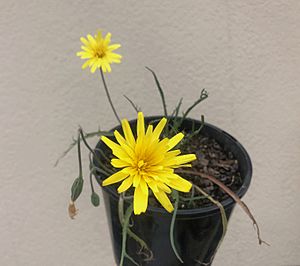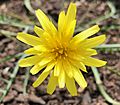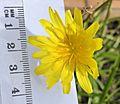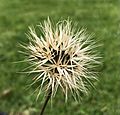Microseris walteri facts for kids
Quick facts for kids Microseris walteri |
|
|---|---|
 |
|
| Scientific classification | |
| Kingdom: | |
| (unranked): | |
| (unranked): | |
| (unranked): | |
| Order: | |
| Family: | |
| Subfamily: |
Cichorioideae
|
| Tribe: |
Cichorieae
|
| Genus: |
Microseris
|
| Species: |
M. walteri
|
| Binomial name | |
| Microseris walteri Gand.
|
|
| Synonyms | |
|
|
Microseris walteri is a special plant from Australia. It's a perennial herb, which means it lives for more than two years. This plant has bright yellow flowers and roots that you can eat! People often call it murnong or yam daisy. There are actually three types of plants known by these names: Microseris walteri, Microseris scapigera, and Microseris lanceolata.
You can find Microseris walteri in the southern parts of Australia. This includes places like Victoria, NSW, ACT, SA, WA, and Tasmania. In Victoria, it grows almost everywhere. It likes many different places, especially dry open forests.
Contents
What is Murnong?
Murnong is a plant that looks a bit like a dandelion. It grows in a clump of leaves close to the ground. These leaves are long and have small teeth along their edges.
How Does Murnong Grow and Reproduce?
Murnong flowers usually appear in Spring. The flower looks like a yellow head made of many tiny flowers, similar to a flatweed or a dandelion. Before the flower opens, its stalk hangs down. But when it's ready to bloom, the stalk stands up straight. This helps attract insects that carry pollen from one flower to another.
After the flower is pollinated, the seed head ripens. It turns into a fluffy ball of tan-colored seeds. Each seed has a crown of fine, feathery parts called a pappus. These fluffy parts help the seeds fly away in the wind, spreading new plants far and wide.
What About the Roots?
The plant usually grows one main root, called a tuber, each year. These tubers can be different shapes and sizes depending on where the plant grows. For example, plants from northwest Victoria often have longer tubers. There's even a rare type from a volcanic area that has a thicker, sometimes branched, root that seems to last for many years.
How Do We Know Its Name?
For a long time, scientists weren't sure about the exact name for this plant. They called it Microseris sp. (meaning "species unknown"), or sometimes Microseris lanceolata or Microseris scapigera.
In 2016, a botanist named Neville Walsh from the Royal Botanic Gardens Victoria helped clear things up. He carefully studied the plants and officially named this one Microseris walteri. He also explained the differences between the three similar Microseris species.
How to Tell the Murnong Plants Apart
It can be tricky to tell the three Microseris plants apart, but here are some key differences:
| Feature | M. walteri | M. lanceolata | M. scapigera |
|---|---|---|---|
| Roots | Has one main, fleshy root that is replaced each year. It's shaped like a turnip or a narrow oval. | Has several fleshy roots that are long and thin. They branch just below the ground. | Has several long, thin roots that usually branch close to the leaves. |
| Fruit (Capsela) | Usually shorter than 7mm. | Usually shorter than 7mm. | Mostly 7–10 mm long. |
| Pappus bristles | About 10 mm long, 0.5–1.3mm wide at the bottom. | 10–20 mm long, about 0.3–0.5 mm wide at the bottom. | 30–66 mm long. |
| Joined petals (Ligule) | Usually longer than 15mm. | Usually longer than 15mm. | Up to 12mm long. |
| Where it grows | Lowlands of southern WA, SA, NSW, ACT, Victoria, and Tasmania. | Rarely on basalt soils; found in high mountain areas of NSW, ACT, and Victoria. | Mostly from flat basalt plains in western Victoria and higher places in Tasmania. |
| Taste of roots | Tastes sweet, whether you eat it raw or cooked. | Tastes bitter, a bit stringy, and not very good to eat. | A bit stringy and slightly bitter, but still okay to eat. |
Cultivation and Uses
The edible roots of murnong plants were once a very important food source for the Indigenous Australians. In the southeastern parts of Australia, Indigenous women would use a special digging stick, also called a yam stick, to dig up the roots. They would then carry the roots in a woven bag called a dillybag.
When they dug for tubers, they often left part of the tuber in the ground. This helped to loosen the soil and encouraged more plants to grow. Murnong roots were usually cooked by placing a dillybag full of tubers onto an earth oven to roast. People describe the taste of the cooked tuber as 'sweet with a flavor like coconut'.
Sadly, when early European settlers brought cattle, sheep, and goats to Australia, these animals ate the murnong plants. This led to the plant almost disappearing, which was a huge problem for the Indigenous communities who relied on murnong for much of their food.
Images for kids






